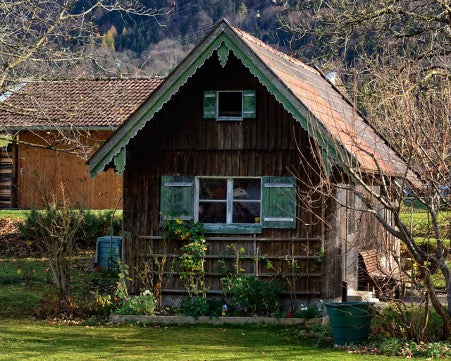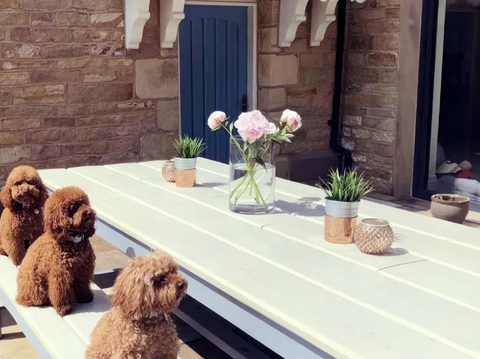How to Care for Garden Furniture
To ensure longevity and optimal performance of your garden furniture, it is important to maintain and care for it regularly. Whether you've got wooden benches, metal tables or wicker chairs, each piece needs special care to protect it from the weather and keep it visually appealing. Cleaning your outdoor furniture regularly, protecting it from the elements and giving it some maintenance every now and then, are key to making your garden furniture last longer. In this article, we'll share some practical tips and tricks for looking after your outdoor furniture so you can keep enjoying it for years to come.
Different Types of Garden Furniture
Garden furniture comes in a variety of materials, with each requiring slighlty different care and maitenance methods. Wooden furniture, while offering a classic and natural aesthetic, requires regular cleaning and protective treatments to prevent moisture damage and rot. Metal furniture, such as aluminum or wrought iron, is durable and resistant to weathering but may require occasional rust prevention measures and touch-ups to maintain its appearance. Wicker or rattan furniture, known for its lightweight and stylish design, should be kept out of direct sunlight to prevent fading and may require occasional reweaving or sealing to preserve its structural integrity. Additionally, synthetic materials like plastic or resin are low-maintenance options that resist fading and moisture damage but may require occasional cleaning to remove dirt and debris buildup.
For a more comprehensive understanding about how to care for the different types of garden furniture, please refer to the list below.
Wood
Looking after your wooden garden furniture is essential to preserve its natural beauty and durability in outdoor settings. Firstly, regularly clean your wooden furniture with soapy water or a specialised cleaner to remove dirt, grime and mildew buildup. Ensure thorough drying after cleaning to prevent moisture retention, which can lead to rot and decay. Annually apply a protective finish, such as a sealant or wood preservative - to shield the wood from moisture, UV rays and insect damage.
Additionally, consider storing wooden furniture indoors or under a weatherproof furniture cover during harsh weather conditions, such as heavy rain or snow. Inspect your furniture periodically for signs of damage or wear, addressing any issues promptly with repairs or refinishing to maintain its longevity and aesthetic appeal. It is also worth taking note of the type of wood your garden furniture is made from. Caring for hardwood and softwood furniture involves slightly different approaches due to variations in their density and susceptibility to damage.
Hardwood
Hardwood furniture, such as oak or teak, is typically more durable and resistant to wear and tear. To maintain hardwood furniture, regular dusting and occasional polishing with a furniture-specific cleaner or oil can help preserve its natural beauty and protect it from scratches. Additionally, avoid direct exposure to sunlight and fluctuations in temperature and humidity, which can cause warping or cracking over time.
Softwood
Softwood furniture, such as pine or cedar, tends to be more susceptible to dents and scratches. To care for softwood furniture, gentle dusting and periodic application of a protective sealant or wood preservative can help maintain its appearance and prolong its lifespan. As with hardwood, softwood is best maintained if you keep it from direct sunlight and store it indoors whenever there are any significant fluctuations in the weather.
Metal
Caring for your metal garden furniture is fairly straight forward. Firstly, implement a regular cleaning routine to remove the dirt, dust and debris which can accumulate on the surface and cause deterioration over time. Use a mild detergent or metal cleaner and a soft cloth or sponge to gently wipe down the furniture, paying particular attention to intricate details and crevices where dirt may accumulate. Additionally, inspect the furniture periodically for signs of rust or corrosion, especially in areas where the paint or protective coating has worn away. If rust is present, use a wire brush or sandpaper to remove it, then apply a rust-inhibiting primer and touch-up paint to prevent further damage. During harsh weather conditions, consider storing metal furniture indoors or covering it with a weatherproof tarp to protect it from moisture and prolong its lifespan.
Rattan
To care for rattan garden furniture it is crucial to regularly remove the dirt and debris which accumulates overtime; this can be done by gently vacuuming or brushing the furniture with a soft brush. Avoid using abrasive cleaners or harsh chemicals that can damage the rattan fibers, instead opting for gentler formulas. To prevent fading and moisture damage keep rattan furniture out of direct sunlight and protect it from prolonged exposure to rain or humidity by storing it indoors or under a weatherproof cover, when not in use. Periodically inspect the furniture for signs of wear or damage, such as loose strands or cracks and address any issues promptly to prevent further deterioration. For maintenance, apply a coat of clear varnish or lacquer every few years to protect the rattan fibers and enhance their durability.
Wicker
Wicker garden furniture requires a delicate touch to maintain its charm and longevity in outdoor environments. Regular cleaning with a soft brush or cloth and a mild soap and water solution is essential for removing any grime and debris. Pay close attention to the weave and crevices of the wicker, as these areas can trap dirt and become breeding grounds for mildew. Avoid using abrasive cleaners or harsh chemicals that can damage the wicker fibers. Additionally, protect wicker furniture from prolonged exposure to sunlight and moisture, as these can cause the fibers to weaken and deteriorate over time. Consider storing wicker furniture indoors or under a weatherproof cover when not in use to prevent damage from the elements.
Plastic
Caring for plastic garden furniture is relatively straightforward and requires minimal effort to keep it looking its best. Regular cleaning with a mild detergent, using a soft cloth or sponge is essential for the proper maintenance of plastic garden furniture; gently scrub the furniture, focusing on any crevices or textured areas where dirt may become trapped. Avoid using abrasive cleaners or harsh chemicals that can scratch or damage the plastic. Additionally, protect plastic furniture from prolonged exposure to sunlight and consider storing the furniture indoors or covering it with a weatherproof tarp to protect it from the elements and prolong its lifespan.
Don't Forget to Apply Protection
Applying protection to your garden furniture is essential for maintaining its longevity and appearance in outdoor environments. Depending on the material of your furniture, different protective measures may be necessary.
- Wooden furniture is best protected by applying a sealant or wood preservative annually, this helps to shield the wood from moisture, UV rays and insect damage.
- Metal furniture can benefit from rust-inhibiting primers and paint to prevent corrosion and maintain its structural integrity.
- Plastic furniture may require UV-resistant coatings to prevent colour fading and degradation.
- Rattan or wicker furniture can be adequatley protected through applying a coat of clear varnish or lacquer which helps to protect the fibres from moisture and fading.
Regardless of the material, regularly cleaning your furniture and storing it indoors or under a weatherproof cover during harsh weather conditions can further extend its lifespan. By applying appropriate protection measures, you can ensure that your garden furniture remains beautiful and functional for years to come.
Ensure that Cushions and Upholstery are Kept Clean
Keeping outdoor cushions and upholstery clean is crucial both for maintaining comfort and for ensuring your garden furniture does not lose it's visual appeal. Outdoor cushions and upholstery can quicly accumulate dirt, stains and mould, especially when exposed to the elements. Regular cleaning not only prolongs the lifespan of the cushions but also ensures a pleasant and inviting seating area for outdoor gatherings.
To clean your outdoor cushions and upholstery, you should begin by removing any loose dirt or debris by shaking or brushing the cushions. Next, spot clean any stains with a mixture of mild detergent and water, gently scrubbing the affected areas with a soft brush or cloth. For more stubborn stains, consider using a specialized fabric cleaner. After spot cleaning, rinse the cushions thoroughly with clean water and allow them to air dry completely in a well-ventilated area. It's also a good idea to regularly vacuum your cushions, this helps to remove dust and prevent the buildup of allergens. Finally, store cushions indoors or in a weatherproof container when not in use, to protect them from the elements and prolong their lifespan. By implementing a regular cleaning routine for your outdoor cushions and upholstery, you can ensure a comfortable and inviting outdoor seating area for years to come.
Take Care When Moving Furniture
Taking care when moving your garden furniture is essential to prevent damage to both the furniture itself and the surrounding environment. Whether you're rearranging your outdoor space or relocating furniture for storage during inclement weather; improper handling can lead to scratches, dents or even structural damage. Additionally, dragging or sliding furniture across surfaces like decks or patios can cause scratches or gouges, compromising the appearance and longevity of your furniture. To avoid such issues, it's crucial to lift and carry furniture whenever possible, using proper lifting techniques to prevent strain or injury.
When moving larger items, such as tables or benches, consider enlisting the help of others to ensure safe and efficient transport. Furthermore, be mindful of obstacles such as planters, garden beds or delicate landscaping features that could be damaged in the process. By taking care when moving your garden furniture, you not only protect your investment but also preserve the beauty and functionality of your outdoor space for enjoyment in the seasons to come.
Repair Any Damage Immediately
It is highly advisable to repair any damage to your garden furniture immediately; this helps to ensure the functionality, safety and aesthetic appeal of your outdoor furniture. Even minor damage, such as loose screws, cracks or chipped paint, can worsen over time if left unattended, leading to more extensive repairs or even rendering the furniture unusable. Additionally, by neglecting to address any damage quickly you may unintentionally compromise the structural integrity of the furniture, posing safety hazards to those who use it. Moreover, visible damage can detract from the overall appearance of your outdoor space, diminishing its charm and inviting atmosphere.
Store Furniture Away Where Possible
Keeping furniture inside when possible is essential for preserving its quality and extending its lifespan. While outdoor furniture is designed to withstand the elements; exposure to prolonged sunlight, rain and humidity can gradually degrade materials and cause damage over time. Bringing your furniture indoors during extreme weather or when it's not in use, protects it from the harsh effects of weathering, such as fading, warping or rusting. Additionally, storing furniture indoors prevents it from being blown around or damaged by strong winds, reducing the risk of accidents and prolonging its overall durability. Indoor storage also helps to ensure your furniture stays clean and hygeinic.
Conclusion
In conclusion, caring for garden furniture is essential for maintaining its quality, functionality and aesthetic appeal over time. By implementing proper cleaning, protection and maintenance practices, you can prolong the lifespan of your furniture and ensure its continued enjoyment in your outdoor spaces. From regular cleaning routines to timely repairs and thoughtful storage solutions, each step plays a crucial role in preserving the integrity of your outdoor furniture. In the long run, by dedicating time and energy to maintaining your garden furniture you ensure an inviting and comfortable garden space, to be enjoyed for years to come.




